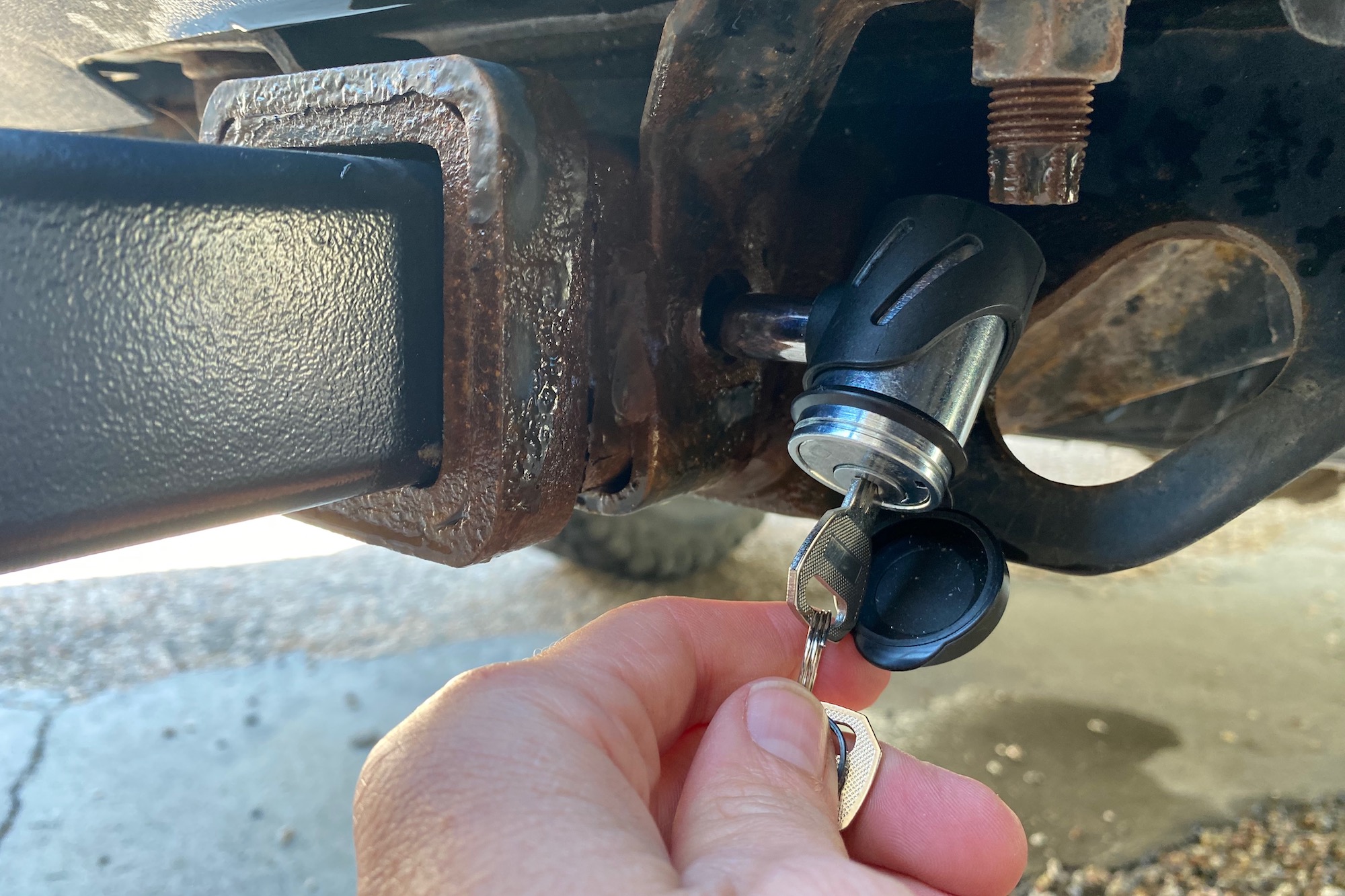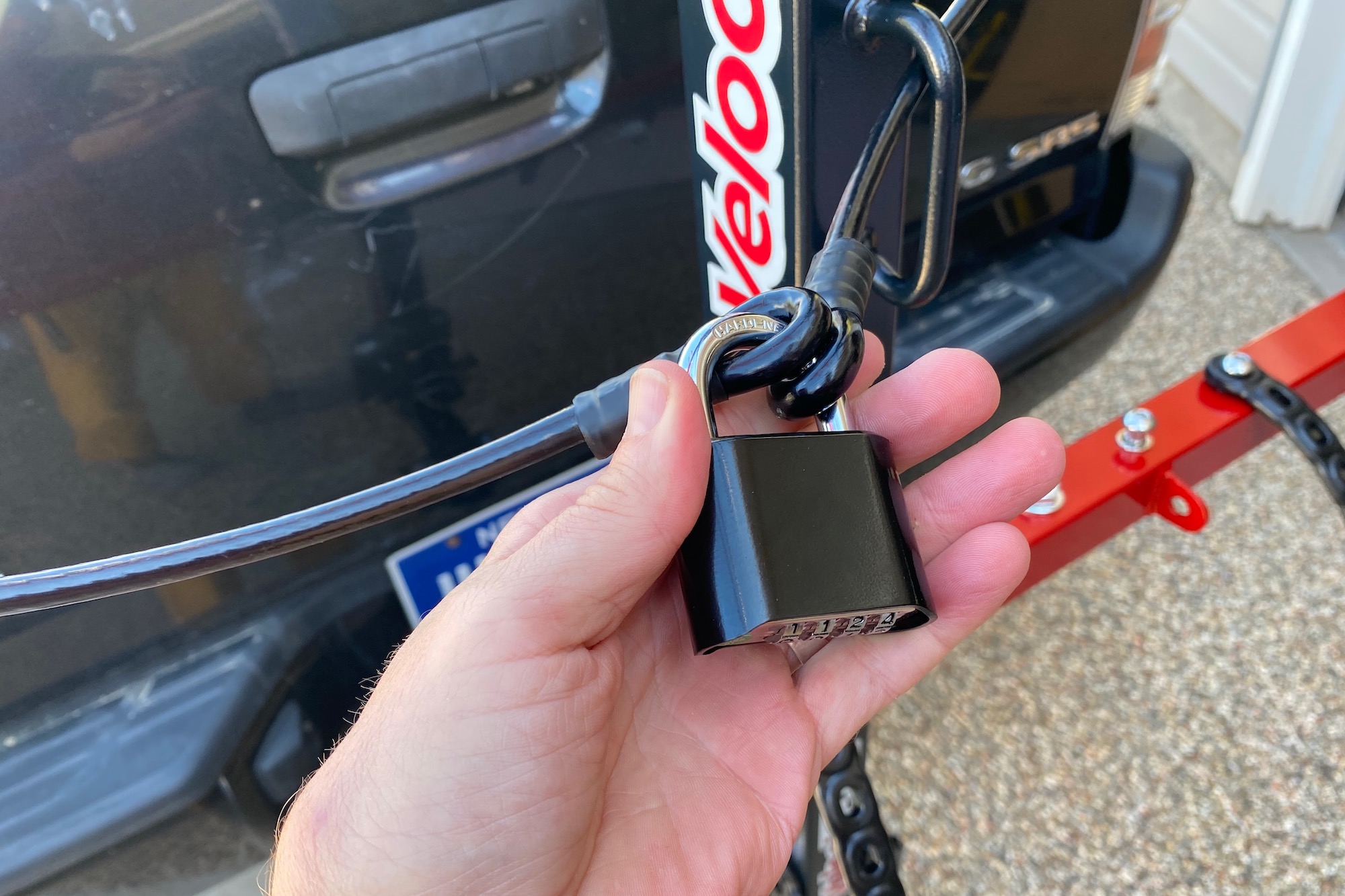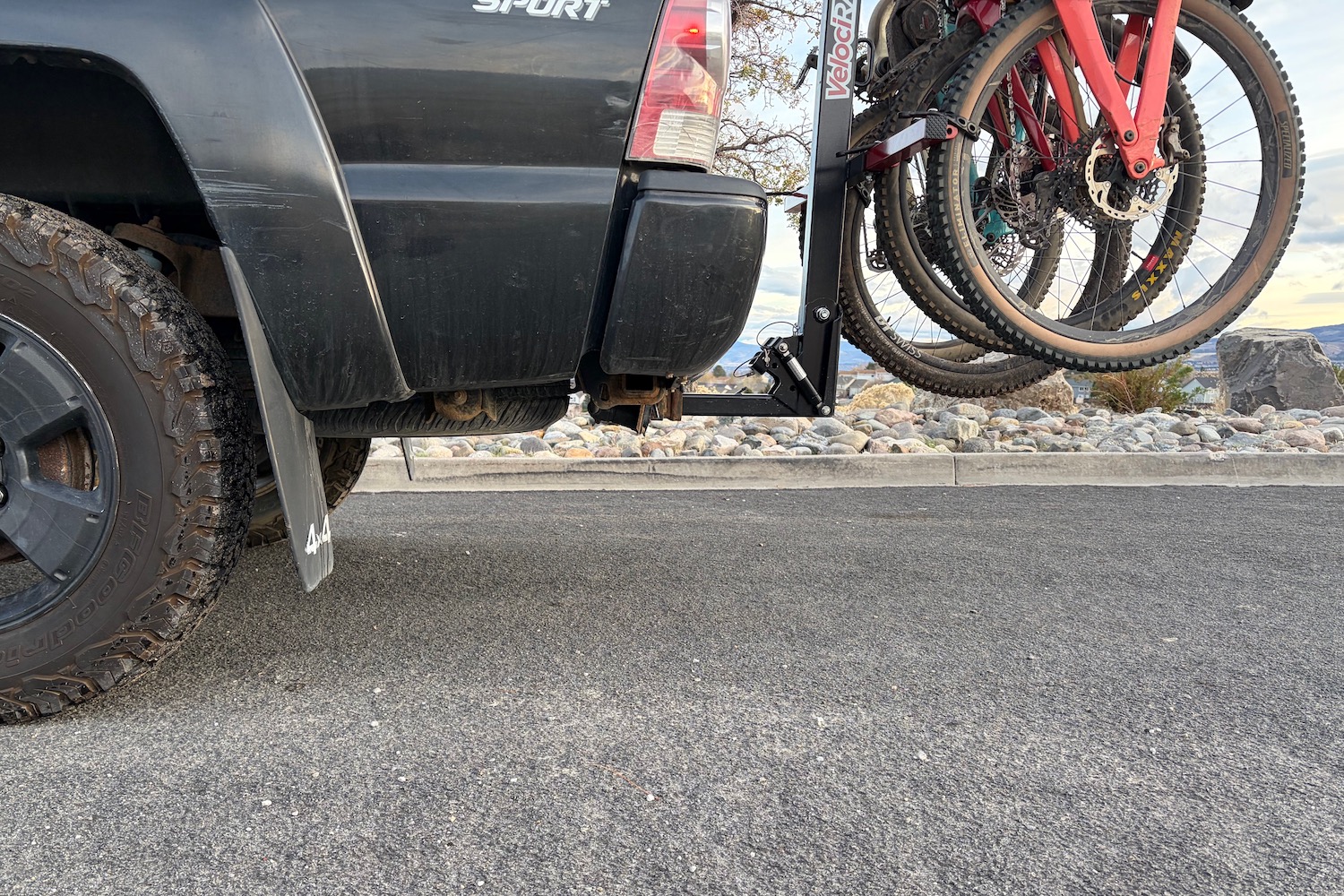VelociRAX has grown into one of the most popular vertical hitch bike rack brands in North America, producing a wide range of models at competitive prices. With sturdy designs, no frame or fork contact, a versatile bike fit, and an easy loading process, VelociRAX are some of the most user-friendly racks of their kind.
The brand’s latest MAX models step up from the originals with weight capacities up to 100 pounds per bike or 300 pounds total. Other updates include a redesigned, larger tilt-release handle, more durable hinge assembly, and an updated center pin for enhanced stability in the vertical lock position. Otherwise, the MAX racks offer the same features, performance, and ease of use that helped popularize VelociRAX to begin with.
I’ve been testing the VelociRAX 412 MAX for the past couple of months while hauling electric and non-electric mountain bikes to and from the trailhead for daily rides. From city streets and highway miles to rough dirt roads, I’ve been scrutinizing its user-friendliness, stability, and all-around performance to see how it compares to the best hitch bike racks on the market.
- MSRP: $1,069
- Number of Bikes: 4 (3, 5, 6, and 7 bike versions available)
- Receiver Sizes: 2" only
- Rack Weight: 80 lbs.
- Per Bike Weight Capacity: 100 lbs. (300 lbs. total)
- Max Wheelbase: Not specified
- Max Tire Width: 3" (fat tire baskets are available)
- Wheel Size Compatibility: 20" to 29"
- Security: Locking hitch pin and welded loop for aftermarket locks (optional integrated cable lock system)
Pros
- Easy loading
- No frame or fork contact
- Damper-assisted lowering
- Class-leading weight limit
- Versatile bike fit – can also carry drop bar bikes
- Comes with garage wall mount
Cons
- Rubber straps can be a little fiddly at times
- Heavy and difficult to carry
- Red baskets and crossbars may not be for everyone
VelociRAX 412 MAX Details
Like all VelociRAX hitch racks, the 412 MAX carries bikes vertically, hanging by the front wheel. A sturdy vertical mast is topped with an upper crossbar with four tire baskets. A lower crossbar has retention straps to secure the rear wheels. The front wheels rest in the angled tire baskets, making contact with the tire only. The stock baskets can accommodate wheels between 20 and 29 inches in diameter and tires up to 3 inches wide. Fat tire (up to 5 inches wide) and small tire (18 to 20 inches in diameter) baskets are sold separately. Rubber straps secure the front wheel in the basket, with another holding the rear wheel against the lower cross bar.
The 412 and other VelociRAX models feature a damper-assisted lowering system. A large handle releases the vertical mast, which tilts down slowly, even with bikes loaded. It has middle and low tilt positions to suit varying needs and vehicle loading heights. The rack locks into position vertically for transport. It also has a camp mode, which allows the rack to be lowered all the way to the ground, where it allows easier access to the rear of the vehicle and functions like a bike stand.

The 412 MAX has 12 inches between bike positions, and the angled tire baskets help to prevent any unwanted handlebar contact. The 412 carries up to four bikes at a time with a per-bike weight limit of 100 pounds and a total weight capacity of 300 pounds. The tire basket design allows for the carrying of bikes with rigid forks and/or drop handlebars. However, with 12-inch spacing, some drop bars may conflict with flat bars, depending on the specific bikes in question. To combat this, VelociRAX makes several models with 15-inch spacing between bikes.
The new MAX models are available in 3X, 412, 5, 5X, 6, and 7-bike versions. The 3X and 5X models have 15 inches of spacing between bikes, whereas the 5, 6, and 7-bike versions have 10 inches. Regardless of the number of bikes each model can carry, the maximum per-bike weight limit is 100 pounds, but the total weight capacity remains steady at 300 pounds. This is to prevent damage to the hitch. On that note, VelociRAX racks are only available in a 2-inch hitch size for use with Class 3 hitches, which have a minimum tongue capacity of 500 pounds. VelociRAX also still sells the original 3X ($799) and 5X ($915) racks, which have a 55-pound weight limit per bike.
The 412 MAX rack I’ve been testing weighs 80 pounds and has dimensions of 58” tall and 49” wide. It has an anti-wobble cam for stability in the receiver, and it comes with a 1/2-inch hitch pin with a keyed metal lock. It also comes with a garage wall mount bracket to keep it off the ground when not in use. When attached to the wall mount, the rack can be used for bike storage.
VelociRAX 412 MAX Assembly

VelociRAX is a consumer-direct brand, and its racks get shipped to your doorstep in several boxes, with some assembly required. Finishing the assembly isn’t too challenging, thanks to detailed printed instructions and an assembly video, but it does take a bit of time. Follow the instructions carefully, and the process is straightforward. Still, be prepared for it to take between 1 and 2 hours, depending on your pace. But, if you live near VelociRAX’s Lehi, Utah location, you can pay an extra $50 and pick it up fully assembled.
Like most hitch racks, VelociRAX recommends assembling it on the vehicle, starting with the hinge assembly in the hitch receiver. Then you install the upper crossbar and tire baskets, followed by the lower crossbar and all of the rubber straps. It’s worth noting that you’ll need your own wrenches for assembly, but it’s fair to assume that most people buying a rack like this probably already have them.

Should you choose to use the garage wall mount, you’ll need to mount that as well. I already have a rack stand in my garage, so I’ve been using that to support the rack when it’s not on my truck. That means I haven’t used the wall mount, but I do really appreciate that VelociRAX includes it with the rack. Storing a large rack like this without a rack stand or wall mount can otherwise be very inconvenient. To install the wall mount, it appears that all you need to do is locate a couple of studs and drive a few screws.
Installation

The VelociRAX 412 MAX is a large bike rack that weighs 80 pounds. I can move it myself, but it’s certainly not easy given its somewhat awkward shape and size. The brand recommends a two-person carry, which does make it much easier to move around. This would be even more important with the larger sizes, as the racks get heavier the more bikes they carry — the 7 MAX weighs a claimed 107 pounds.
Otherwise, installing it is quite easy. Slide the hitch into the receiver and line up the pin holes. Insert the hitch pin and lock it using the included hitch pin lock. Then, tighten the anti-wobble bolt to expand the cam wedge inside the receiver and eliminate any free play in the system. Tightening the anti-wobble bolt does require the use of a socket or other wrench.
Loading Bikes

VelociRAX really did a great job designing its racks to be user-friendly, and this is one of the easiest vertical racks to load/unload that I’ve used. Of course, loading vertical racks requires a little practice and is easiest when done from left to right to avoid interference with the handlebars. With lighter bikes, I found it easy enough to lift them up into position, but this rack is designed so you don’t have to. Pulling on the large tilt-release handle allows the rack to tilt down away from the back of the vehicle. Not only does this lower the height of the tire baskets, allowing you to roll most bikes in and out of the rack, but it also provides easier access to the front and rear wheel straps.
With the rack tilted down, you can tip your bike onto its rear wheel, then basically just roll the front wheel into the wheel basket. The effectiveness of this method will depend on factors such as your bike’s wheelbase and the height of your rack, of course. Even if you can’t roll it straight in, the tilted rack is still much lower if you need to lift the bike into position. I found it especially helpful when loading the 50+ pound Yeti LTe, which I’ve been riding a lot lately. But even for my 30-ish-pound trail bikes, it’s also much easier for my wife and me to get them on and off the rack.

Once the bikes are on, simply secure both the front and rear wheels with the rubber straps. Generally speaking, I’ve found this to be pretty easy, but on a few occasions, I’ve had cold and/or wet hands that made the rubber straps harder to grip and pull. Once the straps are in place, push the rack back up to its upright/travel position until the hinge lever is engaged. Then, move the hinge stop pin to position A (locked) for driving. With just one or two bikes on the rack, it’s relatively easy to push up by yourself. However, a second person can be helpful when dealing with a fully loaded rack that has 4 or more bikes.
To unload, you simply reverse the process. Tilting the loaded rack down couldn’t be easier with the help of the hinge dampers, which lower the rack in a controlled manner. Once lowered, detach the rubber wheel straps, then unload the bikes from right to left.
Stability

On the road, I’ve found the rack to be impressively stable. With vertical racks, you’re pretty much always going to notice a little side-to-side play, and that is the case here. That said, it seems to be a bit more stable than the 1st generation 1Up-USA Recon 5 rack I used to use regularly — and that rack didn’t wobble much either. It goes without saying that the stability of the VelociRAX is dependent on how tightly you secure the anti-wobble cam in the receiver — the brand recommends a torque of 34 Nm.
When attached properly, the bikes also seem very stable and secure in the rack. Sure, they wiggle around a tiny bit over bumps and rough surfaces, but the same is true of any bike rack. With both wheels strapped down tight, the bikes aren’t going anywhere. For heavier e-bikes or use on rough roads, VelociRAX recommends using the included rubber bands on the front and rear brake levers to provide added stability. With the brakes engaged, it reduces bike movement even further. Given that it is designed to handle bikes weighing up to 100 pounds each, you can rest assured that it’s overbuilt and won’t have any issues with eMTBs weighing 50 to 60 pounds.
Versatility

Some of the earliest vertical bike racks held bikes by the crown of suspension forks and typically only worked with mountain bikes. Racks with tire baskets, such as the VelociRAX, are far more versatile and can be used with a wider range of bikes, including mountain bikes, gravel bikes, and even road bikes. With the ability to fit wheel sizes between 20 and 29 inches, tires up to 3 inches wide, and bikes up to 100 pounds, the MAX racks should be able to handle just about any bike you’ve got. Kids’ bikes, heavy electric bikes (without fenders), eMTBs, or your featherlight road bike will all work on this rack.
And, if you ride bikes with fat tires, you can pick up two fat tire baskets ($170) to fit treads up to 5 inches wide. And if you’d rather ski on snow, you can convert the VelociRAX into a ski/snowboard rack with the SkiRAX Attachments ($229). The SkiRAX kit comes with three attachments, each of which can carry up to two pairs of skis or two snowboards, allowing you to load up the whole family and use your VelociRAX all winter long.
Security

VelociRAX includes a beefy hitch pin and a metal hitch pin lock to secure the rack to your vehicle. Additionally, a metal lock loop is welded to the main support, allowing bikes to be secured to the rack with an aftermarket cable or chain lock. VelociRAX also offers an integrated locking system ($90 to $105, depending on the model) that can be purchased and installed. This system fits inside the upper crossbar with cables that slide out of both ends and lock together with a combination padlock. I tested it out and I think it’s a good system. I especially like that it disappears into the rack when not in use. However, like any cable lock, this one is likely to be relatively easy to cut, but it will certainly serve as a solid deterrent against theft for occasional stops.

Value
Bike racks are expensive, and many have increased substantially in price over the last year or so. But if you’re looking to transport more than 2 bikes at a time, vertical racks are one of the most cost-effective ways to do it. Yes, a tailgate pad is obviously the most affordable solution, assuming you have a pickup truck. But outside of that, vertical racks typically offer the lowest price per bike carried. At $1,069 for the 412 MAX, that’s around $267 per bike. With each increase in bike capacity, the price goes up slightly, topping out at $1,219 for the 7 MAX.
For comparison, the Thule Verse carries 2 bikes and sells for $1,000. The 2-bike add-on costs an additional $700, bringing the total to $1,700. That works out to $425 per bike, and a total rack weight of almost 100 pounds. Clearly, the VelociRAX is the less expensive option, although the Verse may be the better choice for those with smaller vehicles or who simply prefer the platform-style rack.

The Thule Revert comes in 4-bike ($1,000) and 6-bike ($1,200) versions, and has a very similar design and features. It even has a damper that assists in lowering and raising the rack’s tilt. The Revert maxes out at 55 pounds per bike, however, which may be a deciding factor for many riders.
Now, $1,000+ is obviously still a lot to pay for a bike rack, but I believe VelociRAX is one of the best values you can find. The brand also enhances this by including a garage wall-mount for storage when not in use. Plus, you can convert it to a ski rack with the SkiRAX attachments and use it year-round. And, if you don’t need to carry bikes weighing over 55 pounds, the standard VelociRAX 3X and 5X are even better values at $799 and $915, respectively.
VelociRAX 412 MAX: My Takeaway

While the vertical hitch rack market was once fairly small, there are now more options than ever. In that somewhat niche market, VelociRAX has established itself as one of the dominant players, and after using the 412 MAX for the past few months, it’s easy to see why. Not only is this rack super sturdy and built to last, but its 100-pound-per-bike weight limit blows the doors off the competition and ensures you’ll never come close to exceeding its capacity.
Its damper-assisted tilt feature and roll-in/roll-out design make it one of the easiest racks to load and unload. The tire baskets support bikes with no frame or fork contact and can fit a huge range of bikes, including those with drop handlebars. It holds bikes securely and is impressively stable on the vehicle, too. To be honest, I’ve got almost nothing negative to say about it. My only real complaint is that I’m not the biggest fan of the color red, but I also respect the brand’s need to stand out from the crowd.
If you’ve been considering a vertical hitch rack, I highly recommend checking out what VelociRAX has to offer. All MAX models are currently $100 off as part of a Black Friday sale promotion, so if you’re already thinking about it, now is a great time to take advantage.

